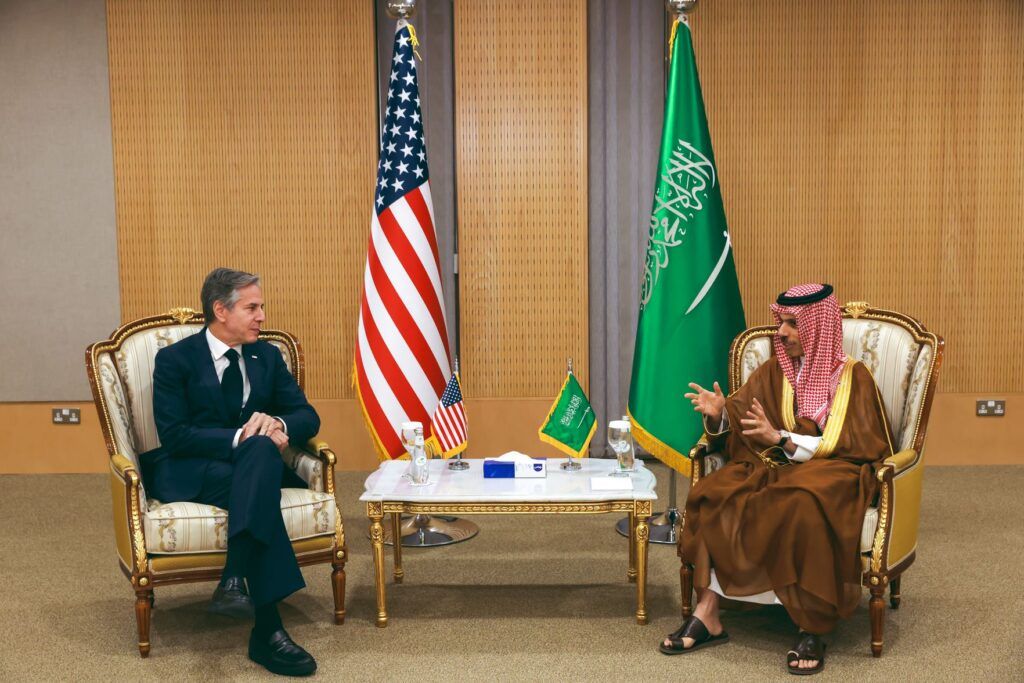Saudi Arabia can alleviate US concerns over its civilian nuclear energy program. Here’s how.
By Bilal Y. Saab, Chen Zak Kane | July 3, 2023
 US State Secretary Antony J. Blinken meets with Saudi Foreign Minister Faisal bin Farhan in Riyadh, Saudi Arabia on June 7, 2023. Despite Blinken’s visit, differences remain over Saudi Arabia's ambitions to develop its own civilian nuclear power industry and Washington seeing it as a potential proliferation risk. (Photo by Hisham Mousa / US State Department, via Flickr)
US State Secretary Antony J. Blinken meets with Saudi Foreign Minister Faisal bin Farhan in Riyadh, Saudi Arabia on June 7, 2023. Despite Blinken’s visit, differences remain over Saudi Arabia's ambitions to develop its own civilian nuclear power industry and Washington seeing it as a potential proliferation risk. (Photo by Hisham Mousa / US State Department, via Flickr)
Saudi leaders have stepped up their plans for developing peaceful nuclear energy, inviting technical bids to the planned construction of two 1.4 gigawatt-electric nuclear reactors and restating the kingdom’s intention to use domestic uranium resources for producing low-enriched uranium as nuclear fuel.
Although open to cooperating with any country willing and able to support its atomic aspirations, Saudi Arabia so far has preferred US nuclear technology. Saudi leaders are now pushing for a joint US-Saudi domestic project on nuclear energy, which would follow the US-Saudi cooperation model of Aramco, the Saudi state oil company. Recent reports suggest that Washington may also consider upgrading military relations if the kingdom normalizes its ties with Israel. In recent weeks and months, President Biden’s top diplomat and national security aides travelled to Riyadh to discuss these very issues with Saudi officials.
But there is one sticking point in US-Saudi nuclear negotiations: Per Saudi wishes, uranium enrichment shall happen on Saudi soil, even as US companies would oversee the development of new nuclear reactors. But Washington has stated that it would consider a deal with Riyadh if it were like the one it brokered with the United Arab Emirates in 2009, which guarantees US cooperation in return for a ban on enrichment and fuel reprocessing—a deal known as the “gold standard.”
To increase the chances of a diplomatic breakthrough, Saudi Arabia has an opportunity to assuage at least some US concerns about its nuclear ambitions and create a more credible and comprehensive profile for itself as a responsible nuclear power by investing in effective nuclear safety and security measures.
An old debate. Much has been said about why Saudi Arabia is increasingly interested in civilian nuclear energy and why there are concerns regarding Riyadh’s motives. In short, the kingdom prioritizes civilian nuclear energy to meet its growing energy needs (today, virtually all of the country’s electricity is generated by burning fossil fuels) and to reduce the costs of its extensive desalination activities and requirements.
The challenge is in the technology itself. The same technologies that produce energy—namely uranium enrichment or plutonium separation to produce fuel for civilian nuclear reactors—can also make the key materials for nuclear weapons. Because of the dual-use nature of nuclear technology, the United States has placed conditions on nuclear energy cooperation with other countries, including the acceptance of enhanced international safeguards on their nuclear programs.
In this debate about Saudi motivations, there has been little discussion of the practical measures that might be used to create a safe and secure Saudi nuclear program. Regardless of which route Riyadh takes—be it through Washington, Beijing, Moscow, or Seoul—the common denominator of all Saudi atomic pursuits is a solid nuclear foundation that prevents not only weaponization but also possible reactor accidents, both of which could turn into region-wide catastrophes.
Saudi Arabia should consider adopting strong nuclear safety and security measures to not only boost negotiations with Washington but also support some critical national and regional security objectives.
To that purpose, investments should be made in four areas.
Safety, safeguards, and security. First, Saudi Arabia should collaborate closely with the International Atomic Energy Agency (IAEA) to implement these measures while it works on developing initial reactor designs. These features must be rigorously tested against realistic and challenging scenarios.
The risks of not having adequate safety, safeguards, and security are significant. Radioactive material theft is one of them. According to the IAEA, from 1993 to 2015, there were 2,889 confirmed cases of “illicit trafficking, thefts, losses,” or “other unauthorized activities and events involving nuclear and other radioactive material worldwide, 762 of which involved theft or loss.”
Such incidents are likely, given the increased demand for nuclear energy in the region. In 2012, for example, during the protests in Egypt, radioactive material was stolen from a nuclear power plant. In Syria, the Jaafar al-Tayyar brigade and al-Nusra Front took advantage of the ongoing civil war to seize the area surrounding the already-destroyed al-Kibar nuclear reactor in early 2013. Likewise, the Islamic State captured two sources of cobalt 60 in Mosul, Iraq, in 2014. Neither the Islamic State nor the Jaafar al-Tayyar brigade and al-Nusra Front managed to acquire fissile or radioactive materials.
Just recently, the IAEA confirmed that 2.5 tons of natural uranium in Libya—initially part of the country’s nuclear weapons program, which was dismantled in 2003—went missing. The Libyan National Army reportedly found barrels containing most of the uranium three miles from the warehouse where they had been stored, but a small amount of material is reportedly still unaccounted for. Such scenarios demonstrate how weak nuclear governance may amplify proliferation risks, especially in conflict-prone contexts.
Protecting nuclear reactors from missiles and drones should be another Saudi (and regional) concern. Nuclear reactors in the Middle East have been an attractive military targets; on at least 13 occasions, nuclear facilities in the region have been targets of attacks. Saddam Hussein targeted Israel’s Dimona reactor, and Israel has bombed research reactors in both Iraq and Syria. During the Iran-Iraq war, Iraq bombed Iran’s Bushehr reactor several times, while Iran conducted an airstrike on Iraq’s Osirak nuclear reactor, the same reactor Israel destroyed a year later.
Of note, the Emirates’ Barakah nuclear power plant and the current sites identified for the Saudi nuclear reactors in the Gulf are less than 200 miles (322 kilometers) from Iran. In December 2017, the Houthis claimed they shot missiles at Abu Dhabi’s nuclear power plant, which was under construction. While the claims could not be substantiated, it would not be the first time a non-state actor targeted a nuclear facility in the region with missiles. Hamas and Hezbollah also have claimed to have shot or aimed at Israel’s nuclear reactor in Dimona.
Saudi Arabia can collaborate with regional and international partners on developing and adopting best practices and guidelines on nuclear safety and security. These could include physical barriers and properly trained security personnel, safety procedures, and constant surveillance using, among other tools, unmanned technologies.
Emergency response. Second, Saudi Arabia can develop plans for responding to nuclear emergencies. This could include training first responders, developing evacuation plans, and stockpiling supplies.
The 2011 Tohoku earthquake and the Fukushima Daiichi disaster in Japan have demonstrated that seismic events can destroy reactor cooling systems and cause nuclear meltdown and contamination. The dependency of Gulf countries on the waterways of the Gulf is a source of increased vulnerability as these countries do not have water storage capacity beyond a few days’ worth of drinking water.
Further, their desalination plants are highly vulnerable to military attacks, while the water sources are susceptible to oil spills and other forms of seawater contamination. Thus, any accident or release of crude oil or nuclear or radioactive material into the waters of the Gulf could threaten the lives and livelihood of millions of people. Such a shared risk among all Gulf countries could be the basis for dialogue about preventing, mitigating, and responding to potential incidents. That’s why emergency preparedness and response are so crucial.
New technologies. Saudi Arabia can further invest in research and development of new nuclear technologies, such as small modular reactors (SMR), by working with regional countries interested in such technologies and possibly partnering with the IAEA to develop safeguards systems for SMRs. In addition to Saudi Arabia, other countries in the region are interested in SMRs, including Jordan and the Emirates. These countries could partner to understand the possible opportunities and risks associated with SMRs—including financial, utility for desalination, proliferation, safeguards, waste management—and work with the IAEA and potential buyers in the region to address the risks, given several regional countries’ hope to rely on SMRs to address their energy needs and water shortages.
Education. Finally, Saudi Arabia can develop regional education and training programs to raise awareness of nuclear energy and its potential benefits and risks. This could include creating a curriculum for schools and universities and providing training for government officials and industry professionals.
Even in the optimal scenarios of Saudi Arabia and the United States agreeing to work together on civilian nuclear energy and Iran’s nuclear genie staying in the bottle, nuclear safety and security issues will remain paramount. And they must be strategized and developed—technically, institutionally, legally, and procedurally—when establishing any new nuclear program.
Natural disasters, radiological terrorism, sabotage operations, and conventional attacks all show how risky the civilian nuclear enterprise in the Middle East can be. However, this nuclear renaissance in the region is coming. Indeed, it’s a matter of when, not if. Saudi Arabia has a real opportunity to exercise regional leadership in this space to secure its own nuclear future but also incentivize the United States—its best partner—to work with it.
Together, we make the world safer.
The Bulletin elevates expert voices above the noise. But as an independent nonprofit organization, our operations depend on the support of readers like you. Help us continue to deliver quality journalism that holds leaders accountable. Your support of our work at any level is important. In return, we promise our coverage will be understandable, influential, vigilant, solution-oriented, and fair-minded. Together we can make a difference.
Keywords: IAEA safeguards, Middle East, Saudi Arabia, nuclear nonproliferation, small modular reactors
Topics: Nuclear Energy, Nuclear Risk
















This is an embarrassing puff piece for the Saudi state that evades the central issue–how to make sure the Saudis don’t use nuclear power facilities to make bombs. This is not a fanciful concern–the current ruler announced that if Iran gets bombs, he will, too, and quickly. Can we even count on him waiting that long? In advising what measures the Saudis could take “to increase the chances of a diplomatic breakthrough,” the authors mean: what the Saudis can dangle in front of the Americans to avoid having them impose the “gold standard” for nuclear exports–no enrichment and no reprocessing.… Read more »
Just have the Saudis build four CANDU reactors and buy ANEEL fuel from the United States. ANEEL is a proprietary fuel technology using a combination of thorium and high-assay low-enriched uranium (HALEU) to enhance the performance of CANDU reactors and other pressurized heavy-water reactor designs. If the Saudis have an international relation issues with United States, then the Saudis can simply fuel with natural uranium. This creates demand for US enrichment of HALEU as well as address Saudi issues of supply security.
The most important first step the Saudis could take to provide reassurance about their nuclear intentions is to replace their Small Quantities Protocol to their Comprehensive Nuclear Safeguards Agreement (CSA) – which is completely inadequate given their significant nuclear power ambitions – with an Additional Protocol (AP) to their CSA. The AP will require the Saudis to provide cradle to grave information about their planned nuclear fuel cycle and give greater access by the IAEA to Saudi facilities and nuclear materials. Additional steps to enhance confidence will be required but this would be a good start.